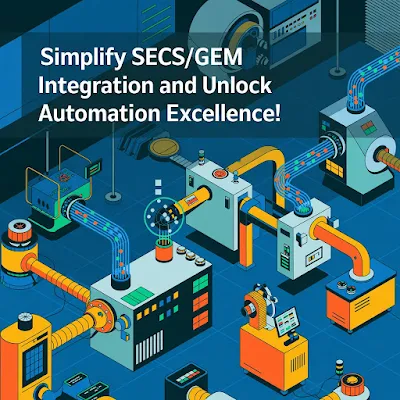In the intricate world of semiconductor manufacturing, precision and automation are paramount. Every step, from wafer processing to final testing, demands seamless communication and control between various pieces of equipment and the overarching factory systems. At the heart of this intricate dance lies a crucial set of standards known as SECS/GEM. Understanding SECS GEM is fundamental for anyone involved in semiconductor equipment design, integration, or operation. This blog post delves into the significance of SECS/GEM, exploring its core principles and its vital role in modern semiconductor fabrication facilities (fabs).
The Semiconductor Equipment and Materials International (SEMI) has developed a suite of standards to facilitate this communication, with the SECS (SEMI Equipment Communications Standard) and GEM (Generic Equipment Model) being the most widely adopted. The SECS GEM protocol provides a standardized way for semiconductor manufacturing equipment to communicate with host computer systems. This standardization is critical, as fabs often utilize equipment from numerous vendors, each with their own unique hardware and software architectures. Without a common language like SECS/GEM, integrating these diverse systems would be a complex and error-prone undertaking.
The foundation of SECS GEM communication lies in the exchange of messages. SECS defines the message structure and content, while GEM specifies the behavior and information that equipment should expose. This includes parameters like equipment status, process data, alarm notifications, and recipe management. The SECS GEM Communication Protocol ensures that these messages are transmitted reliably and interpreted consistently across different systems. This robust communication framework enables host systems to monitor equipment performance in real-time, collect critical process data for analysis, and remotely control equipment operation, leading to increased efficiency and yield.
As semiconductor manufacturing processes become increasingly complex, the need for sophisticated automation becomes even more critical. Initiatives like GEM 300 further build upon the SECS/GEM framework to address the specific requirements of advanced manufacturing. GEM 300 focuses on features like process job management, recipe execution tracking, and material movement automation, pushing the boundaries of equipment control and integration. Implementing SECS/GEM Software solutions is therefore essential for equipment vendors to ensure their products can seamlessly integrate into modern fabs. Similarly, for fab operators, a deep understanding of the SECS/GEM Interface is crucial for effective system management and troubleshooting.
The successful deployment of semiconductor manufacturing equipment hinges on seamless SECS/GEM Integration. This involves not only the physical connection but also the correct configuration and validation of the communication interface. A well-implemented SECS/GEM communication system allows for efficient data acquisition, enabling process engineers to analyze trends, identify potential issues early, and optimize manufacturing recipes. Furthermore, the ability to remotely control equipment through the SECS/GEM Interface minimizes the need for manual intervention, reducing the risk of errors and improving overall throughput.
In conclusion, SECS/GEM serves as the indispensable backbone of automation in semiconductor manufacturing. By providing a standardized framework for equipment communication, the SECS GEM protocol enables seamless integration, real-time monitoring, and remote control of diverse equipment sets. Understanding the principles of SECS/GEM, the intricacies of SECS GEM Communication Protocol, and the advancements brought by initiatives like GEM 300 is crucial for navigating the complexities of modern semiconductor fabrication. As the industry continues to push the boundaries of miniaturization and complexity, the role of robust SECS/GEM Software and effective SECS/GEM Integration will only become more critical in ensuring efficient, high-yield semiconductor manufacturing.
How SECS/GEM Works
The SECS/GEM interface acts as a bridge between the factory’s host computer system and the semiconductor equipment. It supports two primary protocols: SECS-I, which uses RS-232 serial communication, and HSMS (High-Speed SECS Message Services), which leverages TCP/IP for faster data exchange.
Key features of SECS/GEM include:
Data Collection: Factories can use the protocol to retrieve real-time data from equipment, such as process parameters, alarms, and production metrics.
Remote Command Execution: With SECS/GEM communication, factory hosts can send commands to equipment, automating tasks like starting or stopping processes.
Event Reporting: Equipment can report significant events, such as errors or status changes, to the host system.
These features make the SECS/GEM integration process vital for ensuring smooth and efficient manufacturing operations.
The Role of GEM300 in Advanced Automation
As semiconductor processes become more complex, the GEM300 standard extends SECS/GEM functionalities to accommodate 300mm wafer manufacturing. GEM300 includes additional standards like Process Job Management and Carrier Management, addressing the unique needs of larger wafer sizes and more intricate production processes.
Factories leveraging SECS/GEM communication protocols benefit from the following:
Enhanced Efficiency: Automated workflows eliminate bottlenecks, increasing throughput.
Improved Traceability: Detailed data logging ensures compliance and process optimization.
Minimized Downtime: Predictive maintenance features supported by SECS/GEM reduce equipment failure risks.
By integrating SECS/GEM software with GEM300 standards, manufacturers can stay ahead in the race for advanced semiconductor production.
Benefits of SECS/GEM in Semiconductor Manufacturing
The adoption of SECS/GEM communication offers numerous advantages for semiconductor manufacturers:
Standardization: A uniform communication protocol simplifies equipment integration across diverse production lines.
Scalability: SECS/GEM adapts to both small-scale and large-scale manufacturing setups, making it suitable for varying production capacities.
Cost Reduction: Automation minimizes labor costs and enhances resource utilization.
Improved Quality Control: Real-time monitoring and data collection enable rapid detection and correction of issues, reducing defect rates.
Future-Proofing: As a widely accepted standard, SECS/GEM ensures compatibility with future technologies and equipment.
Implementing SECS/GEM: Challenges and Solutions
While the benefits of SECS/GEM integration are undeniable, implementation can present challenges. Common issues include:
Compatibility: Ensuring the SECS/GEM interface aligns with both legacy and modern equipment.
Customization: Adapting the protocol to meet specific factory requirements.
Training: Educating staff on using SECS/GEM communication effectively.
To overcome these challenges, partnering with experienced providers of SECS/GEM software and integration services is crucial. These experts ensure seamless setup, efficient troubleshooting, and ongoing support.
In the rapidly evolving semiconductor industry, automation is no longer optional—it is essential. The SECS/GEM protocol serves as the backbone of this automation, enabling seamless communication, improved efficiency, and superior quality control. Whether through its core features or its extension via the GEM300 standard, SECS/GEM empowers manufacturers to meet the growing demands of the market.
For companies looking to stay competitive, investing in SECS/GEM communication protocols and advanced software solutions is a step toward achieving unparalleled operational excellence. As technology advances, SECS/GEM will undoubtedly continue to play a pivotal role in shaping the future of semiconductor manufacturing.



